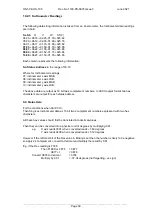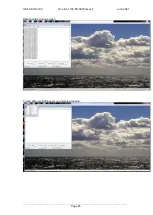
HS-50 & HS-100
Doc. No 1199-PS-0035 Issue 3
June 2021
___________________________________________________________________________________________
Page 51
18 MAINTENANCE & FAULT-FINDING
18.1 Cleaning
If there is any build-up of deposit on the unit, it should be gently cleaned with a cloth moistened with
water and soft detergent. Solvents should not be used, and care should be taken to avoid
scratching any surfaces. The unit must be allowed to defrost naturally after being exposed to snow
or icy conditions, do NOT attempt to remove ice or snow with a tool.
18.2 Servicing
There are no moving parts or user-serviceable parts requiring routine maintenance.
Opening the unit or breaking the security seal will void the warranty and the calibration.
In the event of failure, prior to returning the unit to your authorised Gill distributor, it is
recommended that:
1. All cables and connectors are checked for continuity, bad contacts, corrosion etc.
2. A bench test is carried out as described in Section 19.1.
3. You contact your supplier for advice
18.3 Fault-finding
Symptom
Solution
No output
Check DC power to HS, cable and connections.
Check comms settings of R3 (
as detailed in Section 14)
and host system
match, including correct Com port.
Check unit is in Continuous mode
Check that in-line communication devices are wired correctly.
NOTE: It is usual for Anemometer TX to be connected to converter device RX
Corrupted output
Check comms settings of HS and host system match.
Try a slower baud rate.
Check cable lengths and type of cable.
One way
communication
Check HS and host system are both set to the same protocol (RS232 for PCI,
RS422 for direct connect to HS).
Check wiring is in accordance with the manual.
Failed / Incorrect
WindMaster output,
data invalid flag
Check that transducer path is not blocked
18.4 Status (error) codes
Refer to section 14.2.
18.5 Returning units
If the unit has to be returned, it should be carefully packed in the original packaging and returned to
your authorised Gill distributor, with a full description of the fault condition.
19 TESTS
19.1 Bench test
1. Couple the HS to the host system and power supply, using a known working test cable.
2. Check that the unit is correctly configured.
3. Check for normal output data, and that the Status Code cycles through 01 to 10.
4. If the status code is 00, refer to Section 14.2 Status Fields.
5. Use an office fan or similar to check that the unit is sensing wind, turning the unit to simulate
changing wind direction and to check that all three axes are functioning.
6. Note that this a quick functional test. There are no calibration adjustments.
See 18.2.
Содержание 1199-PK-085
Страница 1: ......



































